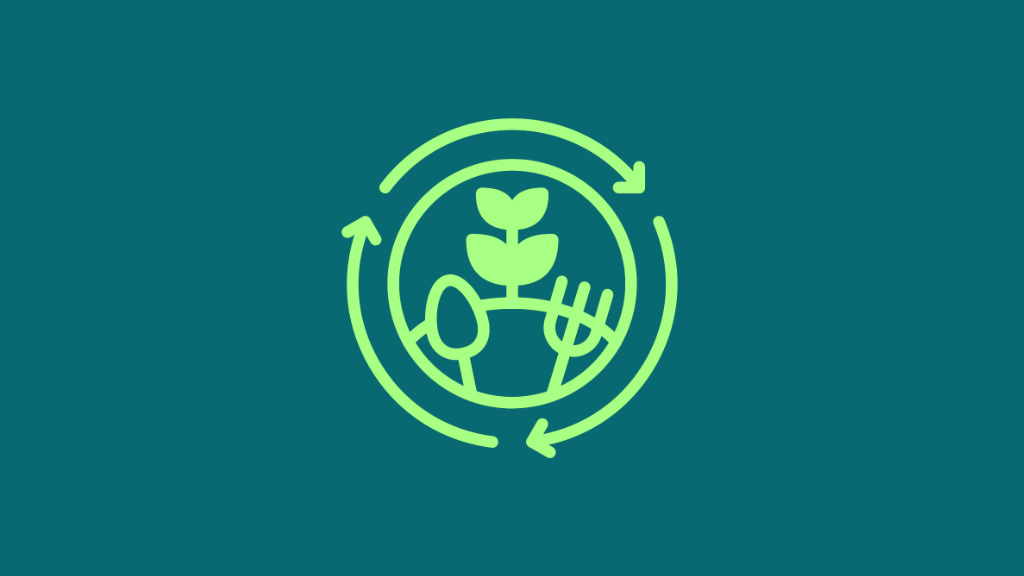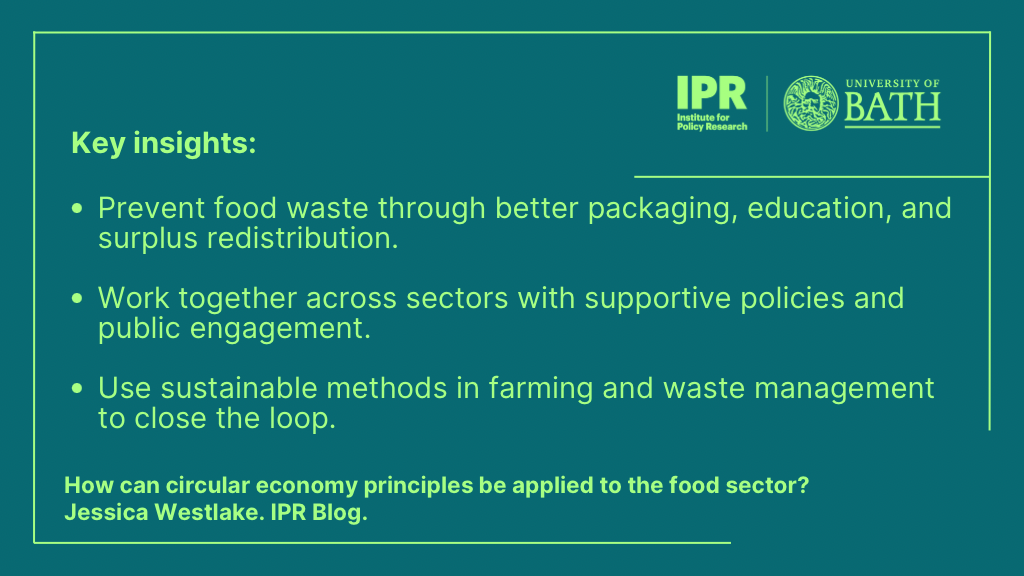A circular food system, explains Jessica Westlake, reduces waste through prevention, education, and redistribution. Collaboration between consumers, businesses, and governments is key, supported by policies and incentives. Sustainable methods like regenerative agriculture and innovative waste management, such as composting and biogas, help close the loop and lower emissions.
Jessica Westlake is a PhD student at the University of Bath. Jess is based in the Department of Chemical Engineering and her research interests include active food packaging materials designed to extend food shelf life and reduce food waste. Her current work focuses on the design of novel materials using naturally derived, degradable polymers in combination with natural antimicrobial compounds. As part of her PhD, Jess undertook a UKRI Policy internship, placed within the Food Research Team at The Waste and Resources Action Programme (WRAP). During the internship, Jess worked with teams collaborating with the Department for Environmental and Rural Affairs (Defra) and UNEP for both citizen- and business-focussed food waste reduction projects. She also has a keen interest in plastics policy, heightened by her attendance at the Portsmouth PlasticsFuture conference (2023).
The linear model of the food sector
The current food system is linear and has been built to support a fast-growing population, industrialisation and urbanisation. This model has resulted in environmental and societal impacts leading to a global recognition that a more sustainable and robust system based on circular economy principles is required. The UNEP Food Waste Index Report (2024) evaluated that 20% of food produced for human consumption is lost or wasted globally, generating up to 10% of global greenhouse gas (GHG) emissions and amounting to a monetary cost estimated at US$1 trillion. The UN developed sustainable development goals (SGDs) for 2030 relating to the food sector including:
- SDG 12.3 (calling for a halving of food waste at retail and consumer level)
- SDG 12.5 (the reduction of waste generation through prevention, reduction, recycling and reuse)
- SDG 13.2 (integrating climate change measures into national policies).
Achieving these goals will rely on a significant change to production and consumption patterns of the food industry. This blog will discuss the food waste prevention, food waste management and the collaborative efforts required by citizens, businesses, educators and governing bodies to achieve a circular economy for the food sector.
Preventing food waste as a priority action
The circular model for the food system will aim to build a system that does not waste. The prevention of food waste should include strategies for achieving this implemented at all stages of the food system from production to consumption. Where prevention is not possible, redistribution of surplus to food banks and food recovery organisations can prevent edible food being wasted. Food waste prevention strategies will be discussed within each section of this blog.
Promoting sustainable food consumption
Household food waste (HHFW) accounts for sixty percent of total food waste. Therefore, the role of consumers is vital in achieving a circular food system. Behaviour change interventions are vital, alongside education measures to increase public awareness and engagement in food waste reduction and prevention. Love Food Hate Waste is a national brand which runs campaigns aimed at reducing HHFW including ‘buy loose’ initiatives for fresh produce, tips for food storage, meal planning and recipes for utilisation of scraps. Therefore, education can allow consumers to feel empowered to be able to eat what they buy and reduce their food waste. For consumers, behaviour interventions including messaging and advertising in supermarkets are required. These interventions will focus on supporting consumers to only buy what they need, saving money and reducing eventual food wastage.
Public awareness
The measurement of food waste and relation to environmental effects and monetary equivalents can be an effective tool to educate public and businesses on the importance of food waste reduction. Policies can be utilised to encourage the design and marketing of products in supermarkets to influence consumers to reduce over-buying practices. Furthermore, incorporation of the circular economy for the food sector would improve general awareness and should translate into increased engagement in food waste reduction strategies. The role of research institutions will be to carry out lifecycle analyses of food production and consumption chains, focusing on minimising GHGs, water usage, energy usage and the use of renewable energy.
Promoting sustainable food production
Producers can contribute to the circular economy by utilising waste-valorisation principles. This will include upcycling byproducts to new food products, input for agriculture or new materials and bioenergy. At the source, farming using regenerative agriculture will be a vital step in the transition to a closed loop system. These measures may include the use of organic fertilisers, diverse crop varieties and rotational grazing. Further waste-reduction methods for circularity may include utilising animal waste as fertiliser and crop residues as animal feed. The aim of these practices will be to positively impact nature and biodiversity.
The role of businesses
Food businesses should focus on sustainable sourcing, from regenerative agricultural practices and local produce. Supermarkets and restaurants should collaborate with redistribution schemes and implement discounts to reduce food waste of edible food nearing its expiration date. Moreover, businesses should consult with experts and utilise the guide published by WRAP, the Food Standards Agency (FSA) and Defra on best practice labelling guidance relating to expiration dates and optimal storage conditions. Marketing teams should also work towards promoting products with the best circularity profiles. Enabling the transition to more circular practices, the Consumer Goods Forum (CGF) brings together manufacturers and retailers within a coalition where members agree to a goal of halving their food waste by 2030, measuring their food waste and reporting this publicly. Furthermore, there are schemes available to help businesses achieve circularity, including Guardians of Grub, which provides tools for the hospitality and food service sector to measure and track their food waste, design menus for waste minimisation and focus on waste-reducing practices such as knife skills.
The role of governing bodies
Ultimately, food waste policies are required to support the transition towards a circular economy. Financial incentives will also be required for businesses, farmers and research institutions to support food waste prevention efforts, support regenerative agriculture efforts and to drive research into the optimisation of the food system. The UK Food and Drink Pact highlights the importance of collaboration across the food system unites organisations with local authorities and other organisations to enable circularity. For food waste to be effectively dealt with, governing bodies will need to incentivise separate collections for food waste and fund innovative waste-management practices and infrastructure.
Waste management innovations
Waste management is a crucial part of achieving circularity in the food system. Current end-of-life options for organic materials include composting, anaerobic digestion and wastewater treatment. However, there are emerging economies for innovative technologies to develop valuable products from this waste including the recycling of food waste into biogas. Logistically, cities will provide the case-studies for these developments due to the proximity of waste-management facilities reducing costs and complexities. Nonetheless, achieving this will rely on community engagement and clear messaging from governing bodies on the optimal use of household waste bins.
Collaborative efforts towards circularity
The connection of farmers and producers with policymakers, businesses and consumers is vital for building a better food system. Collaboration is at the heart of projects such as the Big Food Redesign Challenge, launched by the Ellen MacArthur Foundation and the Sustainable Food Trust. Additionally, Champions 12.3 is a coalition of leaders from all levels of the food system working together to progress towards reducing food waste globally. Overall, the food system can utilise circular economy principles to achieve a sustainable supply chain, efficient resource utilisation and robust waste-management. This new model will allow for a reduction in food waste and GHG emissions and long-term solutions to food production and consumption. Therefore, reducing environmental impacts and creating new economic opportunities.
All articles posted on this blog give the views of the author(s), and not the position of the IPR, nor of the University of Bath.
Respond





